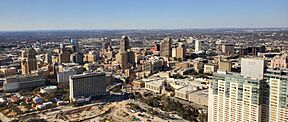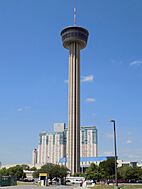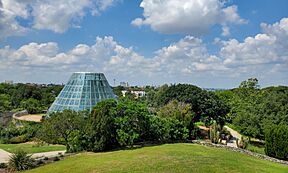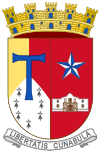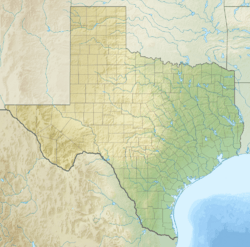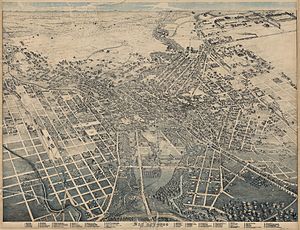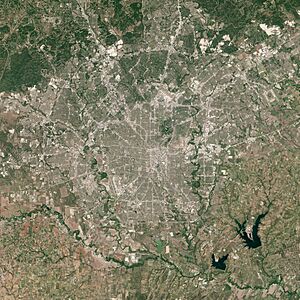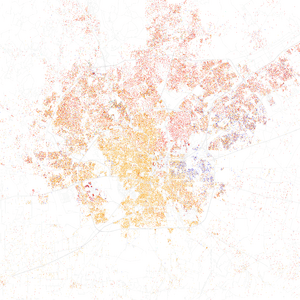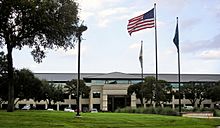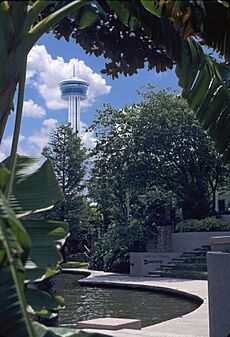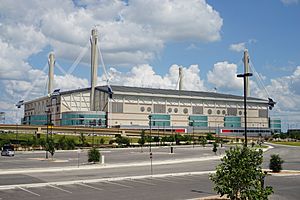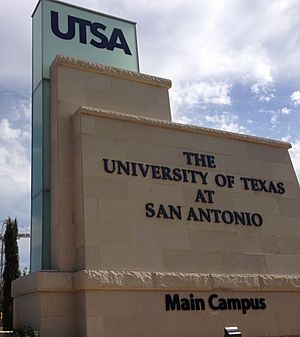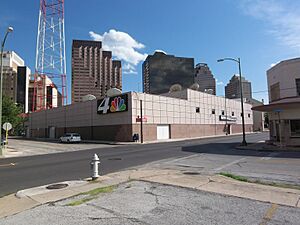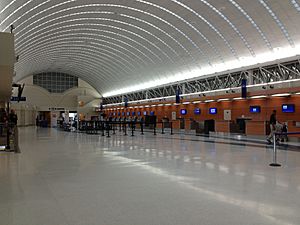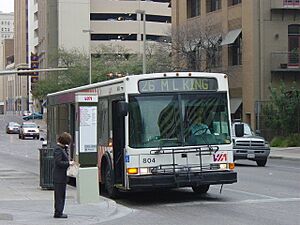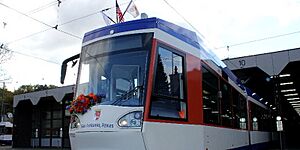San Antonio facts for kids
Quick facts for kids
San Antonio
|
|||||
|---|---|---|---|---|---|
|
|||||
| Nickname(s):
San Antone Alamo City, Military City USA, River City, The 210, S.A., Countdown City, Something to Remember
|
|||||
| Motto(s):
Latin: Libertatis cunabula ("Cradle of Freedom")
|
|||||
| Country | |||||
| State | |||||
| Counties | Bexar, Comal, Medina | ||||
| Foundation | May 1, 1718 | ||||
| Incorporated | June 5, 1837 | ||||
| Named for | Saint Anthony of Padua | ||||
| Government | |||||
| • Type | Council-Manager | ||||
| • Body | San Antonio City Council | ||||
| Area | |||||
| • City | 504.64 sq mi (1,307.00 km2) | ||||
| • Land | 498.85 sq mi (1,292.02 km2) | ||||
| • Water | 5.79 sq mi (14.98 km2) | ||||
| Elevation | 722 ft (220 m) | ||||
| Population
(2020)
|
|||||
| • City | 1,434,625 | ||||
| • Estimate
(2024)
|
1,513,974 | ||||
| • Rank | |||||
| • Density | 2,875.86/sq mi (1,110.37/km2) | ||||
| • Urban | 1,992,689 (US: 24th) | ||||
| • Urban density | 3,248.4/sq mi (1,254.2/km2) | ||||
| • Metro | 2,601,788 (US: 24th) | ||||
| Demonym(s) | San Antonian | ||||
| GDP | |||||
| • Metro | $163.061 billion (2022) | ||||
| Time zone | UTC−6 (CST) | ||||
| • Summer (DST) | UTC−5 (CDT) | ||||
| ZIP Codes |
78201–78266, 78268–78270, 78275, 78278–78280, 78283–78285, 78288–89, 78291–78299
|
||||
| Area codes | 210 (majority), 830 (portions), 726 | ||||
| FIPS code | 48-65000 | ||||
| GNIS feature ID | 2411774 | ||||
| Website | www.SanAntonio.gov | ||||
San Antonio is a big city in Texas, USA. It's the seventh-largest city in the United States. It's also the second-largest city in Texas, right after Houston. San Antonio is known for its rich history and culture.
The city was started by the Spanish in 1718. It was the first official town in what is now Texas. San Antonio is named after Saint Anthony of Padua. His feast day is June 13. The city celebrated its 300th birthday in 2018!
San Antonio is part of a large urban area called the Texas Triangle. This area includes cities like Austin and Dallas. The San Antonio-Austin area has about 5 million people.
Many famous places are in San Antonio. These include the historic Alamo and the beautiful River Walk. Both are very popular with tourists. The city also has fun places like SeaWorld San Antonio and Six Flags Fiesta Texas. San Antonio is home to the San Antonio Spurs basketball team. They have won the NBA championship five times!
The U.S. military has many bases here. This is why San Antonio is called "Military City, USA." The city also has important medical centers. It is home to several large companies. San Antonio has a large Hispanic population, making it a vibrant cultural hub.
Contents
- San Antonio's History: A Journey Through Time
- San Antonio's Geography and Climate
- San Antonio's People and Demographics
- San Antonio's Economy and Jobs
- Arts, Culture, and Fun in San Antonio
- Sports in San Antonio
- Education and Learning in San Antonio
- Media and Communication in San Antonio
- Getting Around San Antonio
- San Antonio's International Connections
- See also
San Antonio's History: A Journey Through Time
Long ago, the Payaya people lived near the San Antonio River. They called their home Yanaguana, meaning "refreshing waters." In 1691, Spanish explorers arrived on June 13. They named the river and area "San Antonio" to honor St. Anthony of Padua.
 Spanish Empire (1718–1821)
Spanish Empire (1718–1821) Mexico (1821–1836)
Mexico (1821–1836) Republic of Texas (1836–1845)
Republic of Texas (1836–1845) United States (1846–1861)
United States (1846–1861) Confederate States (1861–1865)
Confederate States (1861–1865) United States (1865–present)
United States (1865–present)
Years later, in 1718, a Spanish priest named Father Antonio de Olivares started a mission and a town. He built the Misión de San Antonio de Valero (the Alamo). He also built the Presidio San Antonio de Bexar, a fort. These were the beginnings of San Antonio.
The town grew and became the most important Spanish settlement in Texas. In 1731, families from the Canary Islands arrived. They helped form the first official town government in Texas. Many old San Antonio families can trace their roots back to these islanders.

San Antonio was the capital of the Spanish province of Tejas. Later, it became the capital of Mexican Texas. Many American settlers moved into the area. In 1835, Mexico changed its government. This led to the Texas Revolution.
In December 1835, Texian forces captured San Antonio. They defeated Mexican soldiers in the Battle of Bexar. In 1836, Mexican General Antonio López de Santa Anna marched to San Antonio. He attacked the Alamo mission.
The Battle of the Alamo lasted from February 23 to March 6, 1836. The Texian defenders were greatly outnumbered. All of them were killed. These brave men became heroes. "Remember the Alamo" became a famous battle cry for Texas independence.
In 1845, Texas joined the United States. This led to the Mexican–American War. The war hurt San Antonio badly. The city's population dropped by two-thirds. But it soon grew again. By 1860, 15,000 people lived there.
After the American Civil War, San Antonio became a center for the cattle industry. It was a frontier city with a mix of cultures. German immigrants also settled nearby. Many German names are still seen on streets and buildings.
In 1877, the first railroad came to San Antonio. This connected the city to bigger markets. It helped San Antonio grow even more. In the early 1900s, downtown streets were widened. Many old buildings were torn down for modernization.
San Antonio has grown a lot since the late 1900s. Its population has almost doubled in 35 years. In 2015, the San Antonio Missions became UNESCO World Heritage sites. In 2017, San Antonio was named a UNESCO "City of Creativity for Gastronomy." This means it's a special place for food!
San Antonio's Geography and Climate
San Antonio is about 75 miles southwest of Austin. It's also about 150 miles from the Mexico-United States border. The city has gently rolling hills. You can see oak trees, mesquite, and cacti. The Texas Hill Country extends into the northern parts of the city.
The city's main source of drinking water is the Edwards Aquifer. San Antonio also has two lakes, Victor Braunig Lake and Calaveras Lake. These lakes use recycled water to cool power plants. This helps save groundwater.
City Neighborhoods and Districts
San Antonio has many different neighborhoods. Each has its own unique feel.
Downtown San Antonio
Downtown San Antonio is the city's heart. It has many famous buildings and attractions. The River Walk winds through this area. It's a lively place with shops and restaurants.
North Central Area
The North Central area has many upscale neighborhoods. It's home to places like Stone Oak. This area also has upper-middle-class communities.
Northwest Side
The Northwest Side is where you'll find universities. These include the University of Texas at San Antonio. Many companies also have their main offices here, like Valero.
South Side
The South Side has many Latino and Hispanic neighborhoods. It saw big growth when Toyota built a factory here. Colleges like Palo Alto College are also in this area.
East Side
The East Side is home to the San Antonio Stock Show & Rodeo. It also has the Frost Bank Center. This area has the largest number of Black and African American residents.
West Side
The West Side is mostly Hispanic/Latin American. It's a working-class area. But it also has some wealthier parts. Our Lady of the Lake University is located here.
Downtown San Antonio Skyline Panorama.jpg|925px|Skyline of San Antonio (2013)|align-cap=center
Plants and Animals in San Antonio
The natural plants in San Antonio include oak-cedar woodlands. You can also find oak grasslands and chaparral brush. Some unique plants like Cabbage palmetto grow here.
San Antonio has native termites. But it also has an invasive pest called the Formosan Termite. These termites cause a lot of damage to buildings and pecan trees.
San Antonio's Climate and Weather
| Weather chart for San Antonio | |||||||||||||||||||||||||||||||||||||||||||||||
|---|---|---|---|---|---|---|---|---|---|---|---|---|---|---|---|---|---|---|---|---|---|---|---|---|---|---|---|---|---|---|---|---|---|---|---|---|---|---|---|---|---|---|---|---|---|---|---|
| J | F | M | A | M | J | J | A | S | O | N | D | ||||||||||||||||||||||||||||||||||||
|
1.8
61
38
|
1.8
67
42
|
2.3
74
50
|
2.1
80
57
|
4
86
66
|
4.1
91
72
|
2.7
95
74
|
2.1
95
74
|
3
90
69
|
4.1
82
59
|
2.3
71
49
|
1.9
64
41
|
||||||||||||||||||||||||||||||||||||
| temperatures in °F precipitation totals in inches source: NOAA |
|||||||||||||||||||||||||||||||||||||||||||||||
|
Metric conversion
|
|||||||||||||||||||||||||||||||||||||||||||||||
San Antonio has a warm, humid climate. Summers are very hot and long. Winters are mild to cool. The city gets about a dozen nights below freezing each year.
Snow is very rare in San Antonio. It might snow once every two or three winters. But heavy snow is almost unheard of. The biggest snowfall was 16 inches in 1985. In February 2021, the city got 4-6 inches of snow. This caused power outages.
San Antonio can experience floods. It's one of the most flood-prone areas in North America. Heavy rains in 1998 caused $750 million in damage. In 2002, 35 inches of rain fell, causing widespread flooding.
Tornadoes are uncommon but can happen. An F2 tornado lands within 50 miles of the city about once every five years. San Antonio is considered the safest major city in Texas for tornadoes.
The hottest months are July and August. The average high is 95°F. The highest temperature ever was 111°F in 2000. January is the coolest month. The lowest temperature ever was 0°F in 1949.
San Antonio's People and Demographics
| Historical population | |||
|---|---|---|---|
| Census | Pop. | %± | |
| 1850 | 3,488 | — | |
| 1860 | 8,235 | 136.1% | |
| 1870 | 12,256 | 48.8% | |
| 1880 | 20,550 | 67.7% | |
| 1890 | 37,673 | 83.3% | |
| 1900 | 53,321 | 41.5% | |
| 1910 | 96,614 | 81.2% | |
| 1920 | 161,379 | 67.0% | |
| 1930 | 231,542 | 43.5% | |
| 1940 | 253,854 | 9.6% | |
| 1950 | 408,442 | 60.9% | |
| 1960 | 587,718 | 43.9% | |
| 1970 | 654,153 | 11.3% | |
| 1980 | 785,940 | 20.1% | |
| 1990 | 935,933 | 19.1% | |
| 2000 | 1,144,646 | 22.3% | |
| 2010 | 1,327,407 | 16.0% | |
| 2020 | 1,434,625 | 8.1% | |
| 2023 (est.) | 1,495,295 | 12.6% | |
| U.S. Decennial Census 2010–2020, 2021 |
|||
| Racial composition | 2020 | 2010 | 1990 | 1970 | 1950 |
|---|---|---|---|---|---|
| Hispanic or Latino | 63.9% | 63.2% | 55.6% | 51.3% | n/a |
| White (Non-Hispanic) | 23.4% | 26.6% | 36.2% | 41.0% | n/a |
| Black or African American | 6.5% | 6.3% | 7.0% | 7.6% | 7.0% |
| Asian | 3.2% | 2.3% | 1.1% | 0.3% | 0.2% |
| Indigenous | 1.2% | 0.9% | 0.4% | 0.1% | <0.1% |
| Mixed | 2.3% | 1.2% |
In 2020, San Antonio had over 1.4 million people. Most residents are of Hispanic or Latin American background. About 64% of the population is Hispanic. The city also has significant Black and African American and Asian populations.
San Antonio has a lower cost of living than many other big cities. This makes it an attractive place to live. The city's population has grown steadily over the years.
Religious Life in San Antonio
Most people in San Antonio are Christian. Because of its Spanish and Mexican history, Roman Catholicism is very strong here. The Roman Catholic Archdiocese of San Antonio serves many Catholics.
Many Protestants also live in San Antonio. Baptists and Methodists are large groups. Other Christian groups include Pentecostals and Lutherans. There are also Eastern Orthodox churches.
San Antonio has other religions too. Islam is the second largest religion. You can also find communities of Buddhists, Sikhs, and Hindus. The city has a Jewish community with a long history.
San Antonio's Economy and Jobs
| SAT | Corporation | US | ||
| 1 | Valero Energy Corp. | 29 | ||
| 2 | USAA | 103 | ||
San Antonio has a diverse economy. This means it has many different types of jobs. Key industries include the military, health care, and government. Professional services, oil and gas, and tourism are also important.
The city has become a major center for call centers. It also has a growing manufacturing sector, especially for cars. The South Texas Medical Center is a large group of hospitals and research centers.
Millions of tourists visit San Antonio every year. They come to see places like The Alamo and the River Walk. Tourism creates over 130,000 jobs. It brings billions of dollars to the local economy.
San Antonio is home to major companies. These include Valero Energy and USAA. H-E-B, a very large private company, is also based here. Many other companies have offices in the city.
The city is known as "Military City, USA." It has many important military bases. These include Lackland Air Force Base and Fort Sam Houston. These bases provide many jobs.
San Antonio has strong economic ties with Mexico. The city works to build business and cultural connections.
Arts, Culture, and Fun in San Antonio
San Antonio is a very popular place for tourists. The Alamo Mission in San Antonio is Texas's top tourist spot. That's why San Antonio is often called "Alamo City."
The River Walk is another huge attraction. It's a beautiful path along the San Antonio River. You can find many shops, restaurants, and bars there. During holidays like Christmas, the River Walk lights up with festive displays.
Downtown San Antonio has other cool places. These include San Fernando Cathedral and The Majestic Theatre. You can also visit HemisFair '68, home to the Tower of the Americas.
Outside downtown, there's SeaWorld San Antonio. It's one of the biggest marine life parks in the world. The San Antonio Zoo is also a great place to visit. For indoor fun, there's a Sea Life Aquarium downtown.

San Antonio has fun amusement parks. These include Six Flags Fiesta Texas. There's also Morgan's Wonderland, a special park for children with disabilities. Kiddie Park is the oldest children's amusement park in the U.S. It opened in 1925.
The city has many art museums and galleries. The McNay Art Museum was the first modern art museum in Texas. You can also visit the San Antonio Museum of Art. The Witte Museum has exhibits on science, nature, and culture.
The five historic missions, including The Alamo, are UNESCO World Heritage sites. This means they are very important global treasures. The River Walk also has a "Mission Reach" section. It connects the missions with walking and biking trails.
San Antonio has a large network of trails called the Howard W. Peak Greenway Trail System. It has over 82 miles of paths for biking and hiking. Other places to visit include the San Antonio Botanical Garden and the Japanese Tea Gardens.
Annual Events and Festivals
San Antonio hosts many exciting events each year. Fiesta San Antonio is the city's biggest celebration. It's a huge festival with parades and parties. It brings in over $340 million to the economy.
The SAFILM-San Antonio Film Festival happens every summer. It's the largest film festival in South Texas. These events offer lots of entertainment for everyone.
Sports in San Antonio
| Club | Sport | League | Founded | Venue (capacity) | Attendance | Titles | Championship years |
|---|---|---|---|---|---|---|---|
 UTSA Roadrunners |
Football | NCAA Division I | 2011 | Alamodome (65,000) | 27,576 | 2 | |
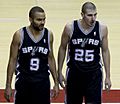 San Antonio Spurs |
Basketball | NBA | 1967 | Frost Bank Center (18,580) | 18,418 | 5 | 1999, 2003, 2005, 2007, 2014 |
 San Antonio Missions |
Baseball | Double-A Central | 1888 | Wolff Stadium (9,200) | 8,500 | 13 | |
 San Antonio FC |
Soccer | USL Championship | 2016 | Toyota Field (8,300) | 6,765 | 1 | 2022 |
 San Antonio Brahmas |
Football | UFL | 2022 | Alamodome (65,000) | 27,576 | 0 |
Professional Sports Teams
San Antonio's most famous sports team is the San Antonio Spurs. They play basketball in the NBA. The Spurs have won five NBA championships. They play their games at the Frost Bank Center.
The city also has a minor league baseball team, the San Antonio Missions. They are part of the San Diego Padres organization. The San Antonio FC soccer team plays in the USL Championship. They won their league championship in 2022.
San Antonio has hosted several football teams over the years. Currently, the San Antonio Brahmas play in the UFL. The city hopes to attract a permanent NFL team one day.
College Sports Teams
The University of Texas at San Antonio (UTSA) has NCAA Division I sports teams. They are called the UTSA Roadrunners. Their football team started in 2011. They set records for attendance in their first year.
The University of the Incarnate Word (UIW) also has NCAA Division I teams. They are the Incarnate Word Cardinals. Their football team has won several championships.
Trinity University has NCAA Division III sports. Their baseball team won the College World Series in 2016.
San Antonio hosts the NCAA football Alamo Bowl every December. It's a big game between teams from the Big XII and Pac-12 conferences. The city also hosts the U.S. Army All-American Bowl. This game features the best high school football players.
Education and Learning in San Antonio
Higher Education Opportunities
San Antonio is a great place for higher education. Over 100,000 students attend its 31 colleges and universities. Public universities include the University of Texas at San Antonio (UTSA). Texas A&M University–San Antonio is also a public option. The Alamo Community College District offers many programs.
Private universities include Trinity University and St. Mary's University. Others are Our Lady of the Lake University and the University of the Incarnate Word. The city also has specialized schools. These include The Culinary Institute of America.
Schools for Kids and Teens
San Antonio is served by many different independent school districts (ISDs). These districts have elementary, middle, and high schools. Some of the main ones are:
- Alamo Heights
- East Central
- Edgewood
- Fort Sam Houston
- Harlandale
- Judson
- North East
- Northside
- San Antonio
- South San Antonio
- Southside
- Southwest
- Somerset
- Comal
San Antonio also has over 30 private and charter schools. The Roman Catholic Archdiocese of San Antonio runs many Catholic schools.
Military Training Centers
San Antonio is a major center for military training. All new Air Force recruits do their basic training here. This happens at Lackland Air Force Base. Over 35,000 new recruits train here every year.
The Military Education and Training Campus (METC) is at Fort Sam Houston. It's the largest medical education center in the world. It trains over 24,000 medical personnel each year.
Media and Communication in San Antonio
Newspapers and Digital News
San Antonio has one main newspaper, the San Antonio Express-News. It has been serving the area since 1865. It's the largest newspaper in South Texas.
The San Antonio Current' is a free weekly paper. It covers local politics, art, and music. The San Antonio Business Journal focuses on business news. La Prensa used to be a bilingual publication with a long history.
The San Antonio Report is a digital-only news source. It covers local civic issues. The San Antonio Observer is the main African American newspaper in the city.
Radio Stations
About 50 radio stations can be heard in San Antonio. iHeartMedia, a very large radio company, is based here. Its main station, WOAI AM-1200, is known for its local news. It can be heard across most of North America at night.
Texas Public Radio is the local National Public Radio (NPR) member. It has stations for news, talk, and classical music. KRTU 91.7 is a college radio station at Trinity University. It plays jazz music.
Many Latin American stations play regional Mexican or Tejano music. The radio scene in San Antonio is very diverse.
Television Channels
San Antonio has several television stations. These include:
- KCWX channel 2 (MyNetworkTV)
- WOAI-TV channel 4 (NBC)
- KENS channel 5 (CBS)
- KLRN channel 9 (PBS)
- KSAT-TV channel 12 (ABC)
- KABB channel 29 (FOX)
- KWEX-DT channel 41 (Univision)
- KVDA channel 60 (Telemundo)
There are also religious and independent stations.
Getting Around San Antonio
Air Travel
The San Antonio International Airport (SAT) is in Uptown San Antonio. It's about 8 miles north of Downtown. It's the 6th busiest airport in Texas. It has two terminals. Many airlines fly to destinations across the U.S. and Mexico.
Stinson Municipal Airport is a smaller airport. It's used mostly for private planes. It's also home to the Texas Air Museum.
Public Transportation
San Antonio has a bus system called VIA Metropolitan Transit. VIA has regular bus routes across the city. It also has express routes to major locations.
VIA also offers a special service for people with disabilities. In recent years, VIA has added hybrid and electric buses. These buses help reduce pollution.
Train Travel
San Antonio is served by Amtrak trains. You can take the Texas Eagle to Chicago. The Sunset Limited goes to New Orleans and Los Angeles. The old train station, Sunset Station, is now an entertainment venue.
Roads and Highways
San Antonio has many major freeways. These include:
- I-10: Runs east to Houston and west to El Paso.
- I-35: Goes south to Laredo and north to Austin and Dallas.
- I-37: Heads southeast to Corpus Christi.
- I-410: This is a 53-mile loop around the city, called Loop 410.
- US 281: Goes north to Johnson City and south to Pleasanton.
- Loop 1604: This is a 96-mile outer loop around San Antonio.
San Antonio has less traffic than other big Texas cities. It's ranked as the 41st most congested city in the U.S.
Biking and Walking
San Antonio has about 136 miles of bike lanes and paths. These trails follow the San Antonio River and greenways. The city is becoming more bicycle-friendly.
A bike sharing service started in 2011. It allows people to rent bikes from different locations.
San Antonio is considered a "car-dependent" city. This means most people rely on cars to get around. This is partly because the city grew quickly after World War II.
The Howard W. Peak Greenway is a large system of hiking and biking trails. It's over 84 miles long. It forms a ring around the city and connects to many parks.
San Antonio's International Connections
Sister Cities Around the World
San Antonio has "sister city" relationships with many cities worldwide. These connections help build cultural and economic ties. Some of its sister cities include:
 – Monterrey, Mexico (1953)
– Monterrey, Mexico (1953) – Guadalajara, Mexico (1974)
– Guadalajara, Mexico (1974) – Las Palmas de Gran Canaria, Spain (1975)
– Las Palmas de Gran Canaria, Spain (1975) – Gwangju, South Korea (1981)
– Gwangju, South Korea (1981) – Kaohsiung, Taiwan (1981)
– Kaohsiung, Taiwan (1981) – Santa Cruz de Tenerife, Spain (1983)
– Santa Cruz de Tenerife, Spain (1983) – Kumamoto, Japan (1987)
– Kumamoto, Japan (1987) – Chennai, India (2008)
– Chennai, India (2008) – Wuxi, China (2012)
– Wuxi, China (2012) – Windhoek, Namibia (2016)
– Windhoek, Namibia (2016) – Darmstadt, Germany (2017)
– Darmstadt, Germany (2017) – Moguer, Spain (2018)
– Moguer, Spain (2018)
Friendship Cities
San Antonio also has "friendship city" agreements. These are similar to sister cities. Some friendship cities include:
 – Suzhou, China (2010)
– Suzhou, China (2010) – Tel Aviv-Yafo, Israel (2011)
– Tel Aviv-Yafo, Israel (2011) – Baguio, Philippines (2022)
– Baguio, Philippines (2022) – Amman, Jordan (2024)
– Amman, Jordan (2024)
|
See also
 In Spanish: San Antonio (Texas) para niños
In Spanish: San Antonio (Texas) para niños


